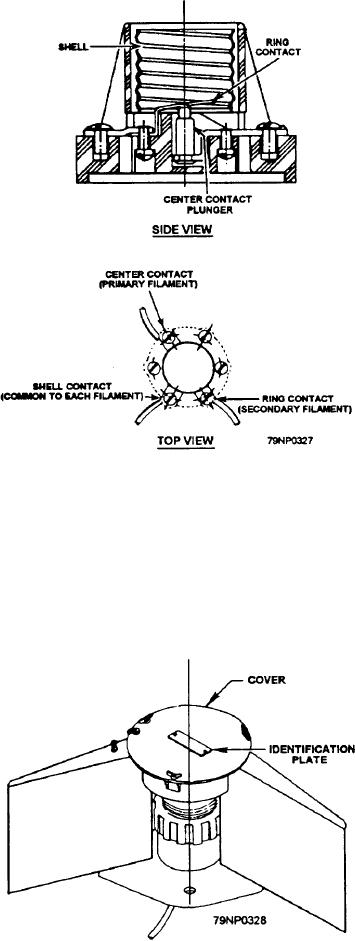
of lens, shown in figure 4-17, view A. The lens is
attached to the fixture base by a cap piece and four
retaining rods and nuts. The cast brass fixtures used for
side and stem lights, respectively, are shown in figure
4-17, views B and C. The brass fixture requires a
three-contact, dual-filament, mogul screw base,
incandescent lamp (fig. 4-17, view D).
Masthead and Stern Lights
The MASTHEAD and STERN LIGHTS require a
50/50-watt lamp. The sidelights require a 100/100-watt
lamp. These fixtures and lenses with the correct lamp
comply with the 1972 COLREGS and do not have to be
replaced
The second type of fixture is a newer lightweight
plastic fixture that uses a domed (open at one end) lens.
Originally these lenses were the smooth type (fig. 4-17,
view E). To comply with the 1972 COLREGS, the
Fresnel-type of lens (fig. 4-17, view F') is required when
these fixtures are used for masthead or side lights. This
plastic fixture requires a three-contact dual-filament,
50/50-watt, medium screw base, incandescent lamp
(fig. 4-17, view H). The lamp holder of this plastic
fixture contains a spring-loaded center contact for the
primary filament, a ring contact for the secondary
filament, and a common shell contact The internal
wiring diagram of the lamp holder is shown in figure
Figure 4-18.--New navigation light fixture lamp holder wiring
4-18.
diagram.
Forward and After Masthead Lights
Port and Starboard Side Lights
The FORWARD and AFTER MASTHEAD
LIGHTS (white) are spraytight fixtures provided with a
The PORT and STARBOARD SIDE LIGHTS are
50-watt two-filament lamp and equipped with an
10-point (112 1/2) lights (fig. 4-19) located on the
external shield to show an unbroken light over an arc of
the horizon of 20 points (225)--that is, from dead
ahead to 2 points (22.5) abaft the beam on either side.
The forward masthead light is located on a mast or
jackstaff in the forward quarter of the vessel. The after
masthead light is located on a mast in the after part of
the vessel. The vertical separation between the
masthead lights must beat least 4.5 meters (14.75 feet),
and the horizontal separation must be at least one half
of the overall length of the vessel or 100 meters (330
feet).
NOTE: For detailed requirements of the navigation
light locations, refer to the 72 COLREGS requirements,
which are printed in the U.S. Coast Guard publication
COMMANDANT, INSTRUCTION M16672.2A and
Code of Federal Regulations, CFR 33-81.20. The U.S.
Navy's certifications of closest possible compliance is
summarized in CFR 32-706. The U.S. Navy's special
Figure 4-19.--Side light fixture.
lights are covered in CFR 32-707.
4-19

